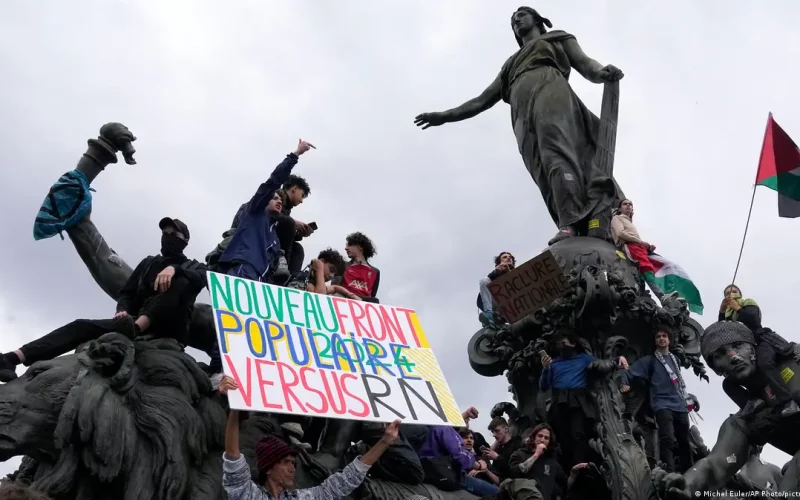The political landscape in many Western nations has been increasingly influenced by the rise of far-right movements. This trend, visible from France to America, has profound implications for democracy, social cohesion, and international relations. This article explores the factors driving this phenomenon, the key players involved, and its potential consequences.
The Rise of the Far Right: A Global Phenomenon

The resurgence of far-right ideologies is not confined to one region but is a global trend affecting many democracies. Factors contributing to this rise include economic insecurity, cultural anxieties, and perceived governmental failures. These movements often gain traction by capitalizing on public dissatisfaction and fears about immigration, globalization, and multiculturalism.
Economic Insecurity: Fueling Far-Right Sentiments
Economic factors play a significant role in the rise of far-right movements. Globalization and technological advancements have led to economic displacement for many, particularly in industrialized nations. In regions where traditional industries have declined, unemployment and underemployment have fostered resentment and a sense of abandonment. Far-right parties often promise a return to national economic stability, protectionism, and job security, appealing to those left behind by economic change.
Cultural Anxieties: Preserving National Identity
Cultural anxieties are another driving force behind the rise of the far right. In many countries, rapid demographic changes and increased immigration have sparked fears about the erosion of national identity and cultural heritage. Far-right movements exploit these fears, promoting a vision of cultural purity and homogeneity. Their rhetoric often includes anti-immigrant sentiments, emphasizing the need to protect the nation’s cultural integrity.
Key Players in Europe: France and Beyond
In Europe, France stands out as a significant example of the far-right surge. The National Rally (Rassemblement National), led by Marine Le Pen, has transformed from a fringe movement to a major political force. Le Pen’s party has softened its rhetoric in recent years, focusing on issues like national sovereignty, anti-immigration policies, and Euroscepticism, thereby attracting a broader voter base.
Other European countries have also seen similar trends. In Germany, the Alternative for Germany (AfD) has gained considerable support by opposing immigration and promoting nationalist policies. In Italy, parties like Lega Nord have capitalized on anti-immigrant sentiments and economic frustrations.
The Far Right in America: A Parallel Trend
The United States has not been immune to the rise of the far right. The election of Donald Trump in 2016 marked a significant shift in American politics, with Trump’s campaign and presidency characterized by nationalist rhetoric, anti-immigrant policies, and a rejection of political correctness. His movement galvanized a segment of the American populace that felt marginalized by globalization and demographic changes.
Post-Trump, far-right ideologies continue to influence American politics. The January 6 Capitol riot in 2021 exemplified the extent to which far-right extremism has permeated the political landscape. Groups like the Proud Boys and Oath Keepers have gained notoriety, advocating for nationalist and often xenophobic policies.
Comparative Analysis: France vs. America
| Aspect | France | America |
|---|---|---|
| Key Parties/Movements | National Rally (Rassemblement National) | Trumpism, Proud Boys, Oath Keepers |
| Primary Issues | Immigration, national sovereignty, Euroscepticism | Immigration, nationalism, anti-globalization |
| Leadership | Marine Le Pen | Donald Trump, various far-right leaders |
| Public Support | Significant electoral gains in recent elections | Significant influence on Republican Party and grassroots movements |
| Recent Developments | Softening rhetoric to broaden appeal | Capitol riot, increasing far-right activism |
Implications for Democracy
The rise of the far right poses several challenges to democratic systems. Far-right parties often adopt populist rhetoric, criticizing established institutions and elites. While this can energize disenfranchised voters, it also undermines trust in democratic processes and institutions. The demonization of the media, judiciary, and political opposition erodes the checks and balances essential for a healthy democracy.
Furthermore, the far-right’s emphasis on exclusionary policies and intolerance can lead to increased societal polarization and conflict. The scapegoating of immigrants and minorities exacerbates social divisions, making it harder to achieve social cohesion.
International Relations: A Shift in Dynamics
The rise of far-right movements also impacts international relations. In Europe, Euroscepticism threatens the stability and unity of the European Union. Far-right parties often advocate for reduced integration and, in some cases, complete withdrawal from the EU, as seen with Brexit.
In the United States, far-right ideologies have influenced foreign policy, leading to a more isolationist stance. The “America First” policy under Trump prioritized national interests over international cooperation, straining relationships with traditional allies and altering global dynamics.
The Future of the Far Right: Trends and Projections
Predicting the future trajectory of the far right is challenging, but several trends are worth noting. Economic and cultural factors are likely to continue driving support for these movements. As long as there are significant segments of the population feeling disenfranchised and anxious about cultural changes, far-right parties will find a receptive audience.
However, the response of mainstream political parties and institutions will be crucial. Efforts to address the underlying economic and social issues driving far-right support could mitigate their appeal. Additionally, promoting inclusive policies and fostering dialogue can help bridge societal divides.
Analysis Table: Factors Driving the Far Right
| Factor | Description | Impact |
|---|---|---|
| Economic Insecurity | Job losses, economic displacement due to globalization and technological advancements | Increases resentment, drives support for protectionist policies |
| Cultural Anxieties | Fears about immigration, demographic changes, and loss of national identity | Fuels xenophobia, promotes exclusionary policies |
| Governmental Failures | Perceived inability of traditional parties to address key issues | Boosts populist rhetoric, undermines trust in institutions |
| Media Influence | Amplification of far-right messages through traditional and social media | Enhances visibility and reach, mobilizes support |
| Leadership | Charismatic leaders who articulate grievances and propose radical solutions | Galvanizes movements, attracts broad voter base |
Comparative Table: Far Right in France and America
| Aspect | France | America |
|---|---|---|
| Key Figures | Marine Le Pen, National Rally | Donald Trump, various far-right leaders |
| Major Policies | Anti-immigration, Euroscepticism, national sovereignty | Anti-immigration, nationalism, anti-globalization |
| Electoral Success | Significant presence in national elections, growing influence | Major influence in Republican Party, grassroots support |
| Public Sentiment | Divided but significant support for far-right policies | Polarized, with strong far-right base |
| Recent Events | Electoral gains, softening rhetoric | Capitol riot, continued activism |
| Media Role | Significant media coverage, both supportive and critical | Extensive media coverage, influence of social media |
The comparative analysis and the factors driving the far right underscore the complexity and significance of this political trend. By understanding these dynamics, policymakers and society can better navigate the challenges posed by the rise of far-right movements.
Conclusion
The march of the far right from France to America highlights significant shifts in the political landscape. Economic insecurity, cultural anxieties, and perceived governmental failures have fueled the rise of far-right movements, which pose challenges to democracy and international relations. Understanding these dynamics is essential for addressing the root causes and mitigating the potential negative impacts on society.












